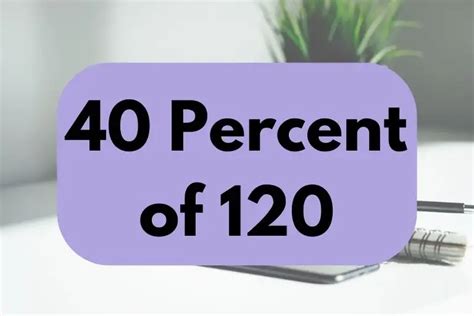40 Of 120 Is What Percent
Kalali
Apr 02, 2025 · 4 min read

Table of Contents
40 out of 120 is What Percent? A Comprehensive Guide to Percentage Calculations
Calculating percentages is a fundamental skill applicable across numerous fields, from everyday budgeting to complex scientific analyses. Understanding how to determine what percentage one number represents of another is crucial for interpreting data, making comparisons, and solving problems. This article delves deep into the calculation of "40 out of 120 is what percent?", providing not only the solution but also a broader understanding of percentage calculations, practical applications, and advanced techniques.
Understanding Percentages
A percentage is a fraction or a ratio expressed as a number out of 100. The term "percent" originates from the Latin "per centum," meaning "out of a hundred." This means that 50%, for instance, represents 50 out of 100, or 50/100, which simplifies to 1/2 or 0.5.
Percentages are used extensively to express proportions, rates, and changes. They offer a standardized way to compare different quantities, making it easier to understand and interpret data.
Calculating "40 out of 120 is What Percent?"
To determine what percentage 40 represents of 120, we can use a simple formula:
(Part / Whole) * 100% = Percentage
In this case:
- Part: 40
- Whole: 120
Substituting these values into the formula:
(40 / 120) * 100% = 33.33% (approximately)
Therefore, 40 out of 120 is approximately 33.33%.
Step-by-Step Calculation
Let's break down the calculation into clear steps:
- Divide the part by the whole: 40 ÷ 120 = 0.3333...
- Multiply the result by 100: 0.3333... * 100 = 33.33...
- Add the percentage symbol: 33.33...%
The repeating decimal 0.3333... is often rounded to two decimal places for practicality, resulting in 33.33%.
Different Methods for Percentage Calculation
While the above method is straightforward, several other approaches can be used to calculate percentages:
1. Using Proportions:
Set up a proportion:
40/120 = x/100
Cross-multiply:
40 * 100 = 120 * x
4000 = 120x
Solve for x:
x = 4000/120 = 33.33...
2. Using a Calculator:
Most calculators have a percentage function. Simply enter "40 ÷ 120 =" and then multiply by 100.
3. Using Spreadsheet Software:
Spreadsheet programs like Microsoft Excel or Google Sheets have built-in functions for percentage calculations. The formula would be =(40/120)*100.
Practical Applications of Percentage Calculations
Percentage calculations are ubiquitous in various real-world scenarios:
- Finance: Calculating interest rates, discounts, taxes, and profit margins. For example, understanding the percentage increase or decrease in your investment portfolio.
- Sales and Marketing: Analyzing sales figures, conversion rates, market share, and customer satisfaction. Determining the success rate of a marketing campaign.
- Education: Calculating grades, test scores, and the percentage of students who passed an exam.
- Science: Expressing experimental results, statistical data, and error margins. Analyzing data sets for trends and correlations.
- Everyday Life: Calculating tips, discounts, and splitting bills. Determining the percentage of a task completed.
Advanced Percentage Calculations: Percentage Change
Beyond simple percentage calculations, understanding percentage change is crucial. This involves determining the percentage increase or decrease between two values.
The formula for percentage change is:
[(New Value - Old Value) / Old Value] * 100%
For example, if a product's price increased from $100 to $120, the percentage change would be:
[(120 - 100) / 100] * 100% = 20% increase.
Conversely, if the price decreased from $120 to $100, the percentage change would be:
[(100 - 120) / 120] * 100% = -16.67% decrease.
Dealing with Complex Percentage Problems
Some percentage problems might involve multiple steps or require a deeper understanding of mathematical concepts. Here are some strategies to tackle these:
- Break down the problem: Divide the complex problem into smaller, manageable steps.
- Identify the unknowns: Determine what information you need to solve the problem.
- Use diagrams or visual aids: Visual representation can help clarify complex relationships.
- Check your work: After solving the problem, check your answer for reasonableness and accuracy.
Percentage Points vs. Percentage Change
It's crucial to differentiate between percentage points and percentage change. Percentage points represent the absolute difference between two percentages, while percentage change represents the relative difference.
For example:
If the interest rate increases from 5% to 10%, the increase is 5 percentage points, but the percentage change is 100% [(10-5)/5 * 100%].
Conclusion: Mastering Percentage Calculations
The ability to calculate percentages effectively is a valuable skill with far-reaching applications. This article provided a thorough explanation of how to determine what percentage 40 represents of 120, along with various calculation methods, practical applications, and advanced techniques. By mastering these principles, you can enhance your analytical skills, improve your decision-making abilities, and confidently navigate numerous quantitative challenges in your personal and professional life. Remember to practice regularly to reinforce your understanding and build confidence in tackling diverse percentage-related problems. The more you practice, the easier it will become to seamlessly integrate these calculations into your daily life and problem-solving strategies.
Latest Posts
Latest Posts
-
How Much Is 71 Inches In Feet
Apr 03, 2025
-
Cuanto Es 43 Grados Fahrenheit En Centigrados
Apr 03, 2025
-
Cuanto Es El 30 De 60
Apr 03, 2025
-
1 Cup Sour Cream In Oz
Apr 03, 2025
-
How Much Is 51 Inches In Feet
Apr 03, 2025
Related Post
Thank you for visiting our website which covers about 40 Of 120 Is What Percent . We hope the information provided has been useful to you. Feel free to contact us if you have any questions or need further assistance. See you next time and don't miss to bookmark.
